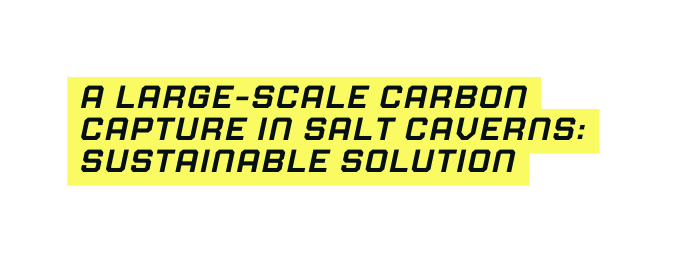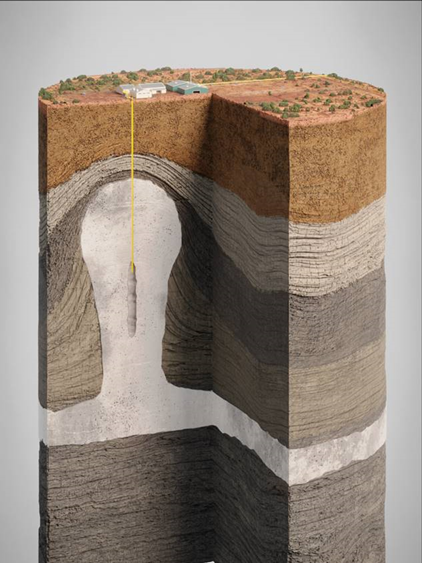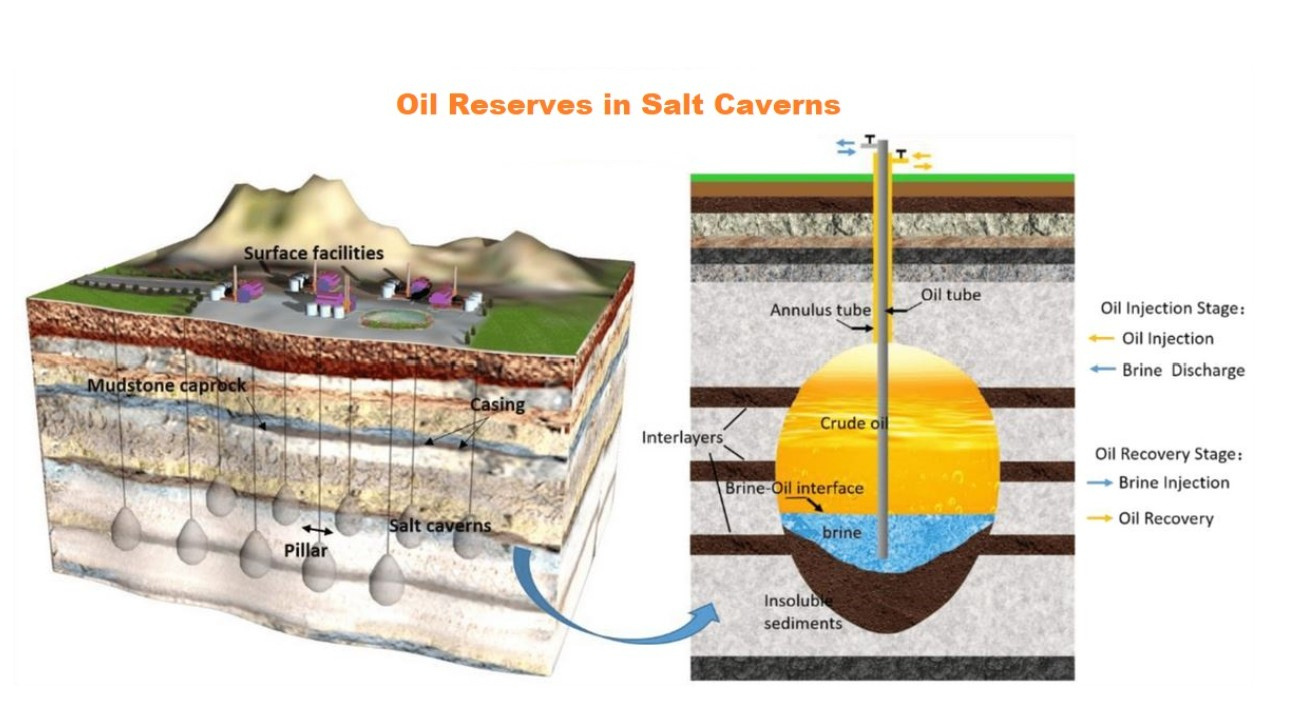Geomechanical
Servives Co., ltd.
Geo
Monkey Cheeks
Carbon capture and storage (CCS)

Carbon capture and storage (CCS) is a crucial technology in the fight against climate change. As the world seeks sustainable solutions to reduce greenhouse gas emissions, innovative methods are emerging, including the use of salt caverns.
In the context of carbon capture and storage (CCS), solution-mined salt caverns can also be employed for the secure storage of captured carbon dioxide (CO2). This is part of efforts to reduce greenhouse gas emissions and combat climate change by sequestering CO2 underground, making them a promising option in the quest for a greener future.
What Are Salt Caverns?
Salt caverns are underground structures created by the dissolution of salt rock which is specially behavior by very low permeability, plasticity, and self-healing ability after damage. Salt caverns are widely used as storage facilities for natural gas, petroleum, compressed air (compressed air energy storage, CAES), hydrogen (underground hydrogen storage), nitrogen, CO2, or even hazardous waste.
Their impermeable nature and stability make them ideal for secure and environmentally safe storage. These caverns can be tailored to specific sizes and shapes, depending on the requirements of the stored material. In underground salt formation, generally, a salt cavern has a quite huge volume, where is located at deep depth range of 300–2000 m.


The Carbon Capture Process
Carbon capture and storage (CCS) is a process that involves capturing carbon dioxide (CO2) emissions from industrial sources and storing them underground in geological formations, such as salt caverns. The process of compressing CO2 into salt caverns can be summarized as follows:
The CO2 is separated from the flue gas or the fuel gas using various technologies, such as chemical absorption, membrane separation, or cryogenic distillation.
The CO2 is compressed to a high pressure, typically above 100 bar, using special compressors designed to handle supercritical fluids.
The CO2 is transported by pipelines or ships to the storage site, where it is injected into deep saline aquifers or depleted oil and gas reservoirs.
The CO2 is stored in salt caverns, which are large cavities created by dissolving salt deposits with water¹. The salt caverns provide a secure and stable environment for CO2 storage, as they have low permeability and high mechanical strength. The CO2 can also be trapped by various mechanisms, such as capillary forces, solubility, mineralization, or hydrate formation.

Safe and Secure Storage
Salt caverns are geologically stable and impermeable, making them a secure choice for long-term carbon storage. They reduce the risk of carbon leakage and environmental contamination.
Large Storage Capacity
Salt caverns have the potential to store vast amounts of captured carbon dioxide (CO2). Their cavernous structures offer a high storage capacity, crucial for handling the large-scale emissions associated with industrial processes.
Near-Zero Emissions
·Carbon capture in salt caverns reduces CO2 emissions significantly. It enables industries to continue their operations while mitigating the environmental impact. This is particularly beneficial for carbon-intensive sectors like cement, steel, and petrochemicals.
Geographic Flexibility
Salt caverns are widely distributed, providing geographic flexibility for carbon capture projects. They can be found in various regions, reducing the need for extensive transportation of captured CO2.
Reduced Energy Requirements
The natural properties of salt caverns, such as their constant temperature, can reduce the energy requirements for compression and injection of CO2, making the process more energy-efficient.

Carbon capture in salt caverns
Use this space to talk about the different components of your company's branding. You can feature the logo, brand colors, typography, or any other elements related to your brand.
Carbon capture in salt caverns significantly contributes to the reduction of greenhouse gas emissions, thereby combating climate change. It plays a vital role in achieving net-zero emissions targets and transitioning to a more sustainable future.
Carbon capture in salt caverns is a sustainable and innovative approach to mitigating climate change. It offers a secure, efficient, and large-scale solution for reducing CO2 emissions from various industries. As the world works towards a greener future, the use of salt caverns for carbon capture is set to play a pivotal role in achieving environmental sustainability. By leveraging this technology, we can take a step closer to a carbon-neutral world.
Why Invest with Us?
Investing in Carbon Capture in Salt Caverns is a unique opportunity with a multitude of advantages




Investing in carbon capture demonstrates your commitment to sustainability and environmental responsibility. Join the vanguard of investors taking decisive action against climate change.
The growing demand for carbon capture solutions, driven by stringent emission reduction targets and sustainability initiatives, promises a high return on investment in this project.
Our project harnesses cutting-edge technologies and established principles in geology and environmental science to create a safe and effective carbon storage solution.
Carbon capture and storage is positioned to play a central role in the transition to a low-carbon economy, offering long-term security for investors.

Geological Stability
Salt caverns provide a stable and secure environment for the long-term storage of CO2, reducing the risk of environmental contamination.
Large Storage Capacity
Salt caverns offer vast storage capacity, accommodating large-scale carbon emissions from various industries.
Environmental Impact
This project significantly contributes to reducing greenhouse gas emissions and helps industries achieve net-zero emissions targets.
Energy Efficiency
Natural properties of salt caverns, such as constant temperature, contribute to the energy efficiency of the carbon capture process.
Our Team
MONGKHOL J.
CEO
PHICHIT S.
COO
DR. KOMKRIT P.
GEOLOGICAL SPECIALIST
GILLES SEGRET
DRILLING FLUID SPECIALIST
20 years’ experience doing petroleum drilling (high pressure and high temp wells) . CEO & CO-Founder to operate and manage one billion THB company investment.
10+ years’ experience doing operation in geological engineering.
10+ years’ experience of geomechanical engineering.
Broad experience in drilling fluids, well cementing. Have worked on different projects from land to deep-water operations, ERD's wells, HPHT
(UHT fluids and slurry).

We invite you to join us at an upcoming Investor Information Session, where you can gain deeper insights into this exciting opportunity. Learn about our project's scope, potential returns, and the impact of your investment on a sustainable future. The event will also provide a chance to meet our team and ask any questions you may have.

Phone
(+66) 991959165
ceo@geoagni.com